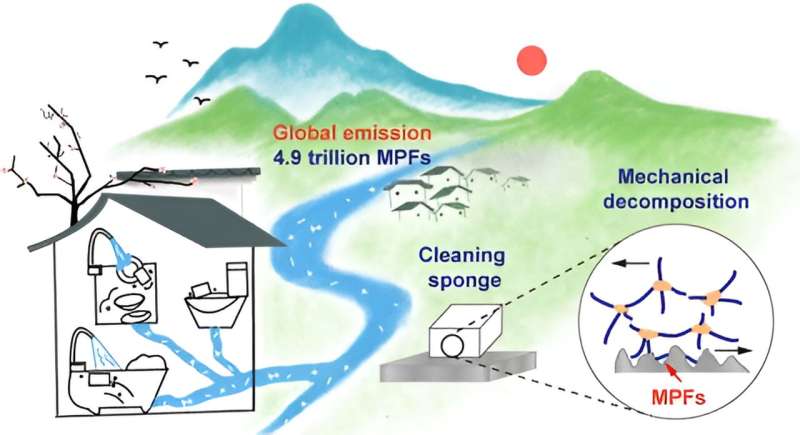This article has been reviewed according to Science X's editorial process and policies. Editors have highlighted the following attributes while ensuring the content's credibility:
fact-checked
peer-reviewed publication
trusted source
proofread
Melamine sponges shed microplastics when scrubbed, study shows

If you own a pair of white shoes or have ever tried to remove crayon from a wall, you're probably thankful for melamine sponges. These products practically erase tough stains and scuffs through their unique abrasiveness and without additional cleaning products. But these "magic" sponges shed microplastic fibers when worn down.
Researchers publishing in the journal Environmental Science & Technology report that, worldwide, melamine sponges could release over a trillion microplastic fibers every month.
Melamine foam is made of poly(melamine-formaldehyde) polymer—a network of hard, plastic strands assembled into a soft, lightweight foam that's surprisingly abrasive, making it the perfect material for very scrubby sponges. But, as the sponges wear away from use, the foam breaks down into smaller pieces that can release microplastic fibers that wash into sewer systems.
Once released into the environment, the fibers can be consumed by wildlife and make their way into the food chain. Yu Su, Baoshan Xing, Rong Ji and colleagues wanted to see how a melamine sponge's density and the roughness of the surface it scrubs affect how quickly the foam breaks down, as well as calculate how many microplastic fibers the sponge sheds.
The team purchased several sponges from three popular brands, then repeatedly rubbed them against textured metal surfaces, causing the foam to wear down.
They found that sponges made from denser foam wore down more slowly and produced fewer microplastic fibers than less dense sponges. Next, the team determined that a single sponge releases approximately 6.5 million fibers per gram of worn-out sponge and assumed that all sponges sold, on average, are worn down by 10%.
To get a rough idea of how many fibers could be released per month, they looked at Amazon's monthly sales for August 2023. Assuming these numbers stay consistent, the team calculated that 1.55 trillion fibers from melamine sponges could be released every month. However, this number only takes into account one online retailer, so the actual amount could be even higher.
To help minimize the emission of microplastic fibers, the researchers recommend that manufactures create denser, tougher sponges that are more resistant to wear. Additionally, they suggest that consumers opt for natural cleaning products that do not use plastics and recommend installing filtration systems to capture sloughed-off microplastic fibers either in the home or in wastewater treatment plants.
More information: Yu Su et al, Mechanochemical Formation of Poly(melamine-formaldehyde) Microplastic Fibers During Abrasion of Cleaning Sponges, Environmental Science & Technology (2024). DOI: 10.1021/acs.est.4c00846
Journal information: Environmental Science & Technology
Provided by American Chemical Society





















